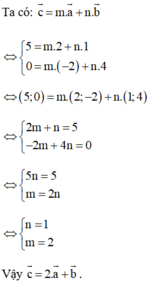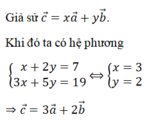Hãy nhập câu hỏi của bạn vào đây, nếu là tài khoản VIP, bạn sẽ được ưu tiên trả lời.

Chào bạn . bạn tham khảo đáp án này nhé
1.A
2.C
3.B
5.B
6.C
7.A
Riêng câu 4 mk chưa hiểu ý bạn nên bạn xem lại câu hỏi rồi viết lại đề nhé
Thanks

a) Ta có: \(\overrightarrow {AB} = (3 - 1;4 - 2) = (2;2)\) và \(\overrightarrow {CD} = (6 - ( - 1);5 - ( - 2)) = (7;7)\)
b) Dễ thấy: \((2;2) = \frac{2}{7}.(7;7)\)\( \Rightarrow \overrightarrow {AB} = \frac{2}{7}.\overrightarrow {CD} \)
Vậy hai vectơ \(\overrightarrow {AB} \) và \(\overrightarrow {CD} \) cùng phương.
c) Ta có: \(\overrightarrow {AC} = ( - 1 - 1; - 2 - 2) = ( - 2; - 4)\) và \(\overrightarrow {BE} = (a - 3;1 - 4) = (a - 3; - 3)\)
Để \(\overrightarrow {AC} \) và \(\overrightarrow {BE} \) cùng phương thì \(\frac{{a - 3}}{{ - 2}} = \frac{{ - 3}}{{ - 4}}\)\( \Leftrightarrow a - 3 = - \frac{3}{2}\)\( \Leftrightarrow a = \frac{3}{2}\)
Vậy \(a = \frac{3}{2}\) hay \(E\left( {\frac{3}{2};1} \right)\) thì hai vectơ \(\overrightarrow {AC} \) và \(\overrightarrow {BE} \) cùng phương
d)
Cách 1:
Ta có: \(\overrightarrow {BE} = \left( {\frac{3}{2} - 3; - 3} \right) = \left( { - \frac{3}{2}; - 3} \right)\) ; \(\overrightarrow {AC} = ( - 2; - 4)\)
\( \Rightarrow \overrightarrow {BE} = \frac{3}{4}.\overrightarrow {AC} \)
Mà \(\overrightarrow {AE} = \overrightarrow {AB} + \overrightarrow {BE} \) (quy tắc cộng)
\( \Rightarrow \overrightarrow {AE} = \overrightarrow {AB} + \frac{3}{4}.\overrightarrow {AC} \)
Cách 2:
Giả sử \(\overrightarrow {AE} = m\,.\,\overrightarrow {AB} + n\,.\,\overrightarrow {AC} \)(*)
Ta có: \(\overrightarrow {AE} = \left( {\frac{1}{2}; - 1} \right)\), \(m\,.\,\overrightarrow {AB} = m\left( {2;2} \right) = (2m;2m)\), \(n\,.\,\overrightarrow {AC} = n( - 2; - 4) = ( - 2n; - 4n)\)
Do đó (*) \( \Leftrightarrow \left( {\frac{1}{2}; - 1} \right) = (2m;2m) + ( - 2n; - 4n)\)
\(\begin{array}{l} \Leftrightarrow \left( {\frac{1}{2}; - 1} \right) = (2m - 2n;2m - 4n)\\ \Leftrightarrow \left\{ \begin{array}{l}\frac{1}{2} = 2m - 2n\\ - 1 = 2m - 4n\end{array} \right. \Leftrightarrow \left\{ \begin{array}{l}m = 1\\n = \frac{3}{4}\end{array} \right.\end{array}\)
Vậy \(\overrightarrow {AE} = \overrightarrow {AB} + \frac{3}{4}.\overrightarrow {AC} \)

a: \(cos\left(\overrightarrow{a},\overrightarrow{b}\right)=\dfrac{\left|0\cdot4+4\cdot\left(-2\right)\right|}{\sqrt{0^2+4^2}\cdot\sqrt{4^2+2^2}}=\dfrac{8}{4\cdot2\sqrt{5}}=\dfrac{1}{\sqrt{5}}\)
b: \(\left(\overrightarrow{a}+2\cdot\overrightarrow{b}\right)=\left(8;0\right)\)
\(\left(\overrightarrow{a}+2\overrightarrow{b}\right)\cdot\overrightarrow{c}=-1\)
nên \(8x+0y=-1\)
=>x=-1/8
\(\left(-\overrightarrow{b}+2\cdot\overrightarrow{c}\right)=\left(-4+2x;2+2y\right)\)
\(\overrightarrow{a}\left(-\overrightarrow{b}+2\overrightarrow{c}\right)=8+8y=6\)
=>8y=-2
=>y=-1/4

Câu 4:
Áp dụng định lý Pytago
\(BC^2=AB^2+AC^2\Rightarrow BC=2\)
Ta có:
\(\overrightarrow{CA}.\overrightarrow{BC}=-\overrightarrow{CA}.\overrightarrow{CB}=-\dfrac{CA^2+CB^2-AB^2}{2}=-\dfrac{2+4-2}{2}=-2\)
Câu 5:
Gọi M là trung điểm BC
\(\overrightarrow{AM}=\dfrac{1}{2}\left(\overrightarrow{AB}+\overrightarrow{AC}\right)\)
Mà: \(\overrightarrow{AG}=\dfrac{2}{3}\overrightarrow{AM}=\dfrac{1}{3}\left(\overrightarrow{AB}+\overrightarrow{AC}\right)\)
Câu 6:
\(\left|\overrightarrow{a}-\overrightarrow{b}\right|=3\)
\(a^2+b^2-2\overrightarrow{a}.\overrightarrow{b}=9\)
\(\overrightarrow{a}.\overrightarrow{b}=\dfrac{1^2+2^2-9}{2}=-2\)
Câu 7:
\(\left|\overrightarrow{AB}-\overrightarrow{AD}+\overrightarrow{CD}\right|=\left|\overrightarrow{DB}+\overrightarrow{CD}\right|\)
\(=\left|\overrightarrow{DB}-\overrightarrow{DC}\right|=\left|\overrightarrow{CB}\right|=BC=a\)




Đáp án A